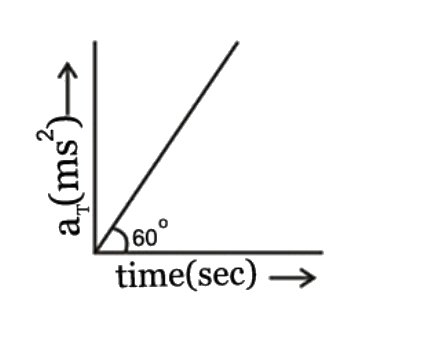In the s-t graph of a particle with uniform acceleration at time t makes an angle 45∘ with the time axis. After one second it makes angle of 60∘. What is the acceleration of the particle?Solution in Bengali
Initial velocity of the particle u = tan 45∘ =1 unit
After time 1 s the final velocity of the particle,
v = tan 60∘=√3 unit
As the particle moves with uniform acceleration (a) so
a = change in velocitytime=(√3−1) unit
Topper's Solved these Questions
- BOOK - CHHAYA PUBLICATIONCHAPTER - ONE - DIMENSIONAL MOTION EXERCISE - EXAMINATION ARCHIVE with solutions (WBJEE )4videos
ONE - DIMENSIONAL MOTION
- BOOK - CHHAYA PUBLICATIONCHAPTER - ONE - DIMENSIONAL MOTION EXERCISE - EXAMINATION ARCHIVE with solutions (JEE Main )4videos
ONE - DIMENSIONAL MOTION
- BOOK - CHHAYA PUBLICATIONCHAPTER - ONE - DIMENSIONAL MOTION EXERCISE - ENTRANCE CORNER ( Integer answer type )5videos
ONE - DIMENSIONAL MOTION
- BOOK - CHHAYA PUBLICATIONCHAPTER - NEWTONIAN GRAVITATION AND PLANETARY MOTIONEXERCISE - CBSE SCANNER19videos
NEWTONIAN GRAVITATION AND PLANETARY MOTION
- BOOK - CHHAYA PUBLICATIONCHAPTER - QUESTION PAPERS OF NEET -2017EXERCISE - QUESTION32videos
QUESTION PAPERS OF NEET -2017
Similar Questions
A particle moves with constant acceleration along a straight line starting from rest. The percentage increase in its displacement during the 4th second compared to that in the 3rd second is
02:20View SolutionFrom a tower of height H, a particle is thrown verticially upward with a speed u. The time taken by the particle to hit the ground is n times that taken by it to reach the highest point of its path. The relation between H, u and n is
02:30View SolutionThe displacement x of a particle moving in one dimension under the action of a constant force is related to time t by the equation t = √x+3 where x is in meters and t is in seconds. Finds the displacement (in metres ) of the particle when its velocity is zero.
03:50View SolutionWhat is the reason for absence of atmosphere in some planets?
04:17View SolutionA molecule of a substance has permanent dipole moment p . A mole of this substance is polarised by applying a storg electrostatic field E . The direction of the field is suddenly changed of 60∘ . If N is the avogadro's number the amount of work done by the field is
02:48View SolutionDisplacement-time curve of a particle moving along a straight line is shown. Tangents at A and B makes angle 45^(@) and 135^(@) with positive x -axis respectively. The average acceleration of the particle during t=1,t=2 seconds is
04:32View SolutionThe distance time graph of a particle at time t makes angle 45^(@) with respect to time axis. After 1s , if makes angle 60^(@) with respect to time axis. What is the acceleration of the particle?
02:36View SolutionThe V-t graphs of two objects make angle 30° and 60° with the time axis. Find the ratio of their accelerations
04:08View SolutionTangental acceleration of a particle moving in a circle of radius 1 m varies with time t as shown in figure (initial velocity of the particle is zero). Time after which total acceleration of particle makes an angle of 30∘ with radial acceleration is
 02:13View Solution
02:13View SolutionAfter time t a parallelogram of the completed particle st with the time axis 45^(@) Forms angles. That angle after one second 60^(@) What is the acceleration of the particle?
01:03View Solutions-t graph for a partical, moving with a constant acceleration, subtends 45^(@) angIe with the time axis at time t. That angle becomes 60^(@) 1s Iater. Find the acceleration of the partical.
03:50View SolutionThe s-t graph of a particle moving with constant acceleration at time t, makes an angle 45∘ with the time axis. After 1 second the angle changes to 60∘. Find the acceleration of the particle.
03:15View SolutionThe distance time graph of a particle at time t makes an angle of 45^(@) with time axis. After 1 second it makes an angle of 60^(@) with time axis, what is the acceleration of the particle ?
07:44View SolutionThe V-t graphs of two objects make angle 30∘ and 60∘ with the time axis. Find the ratio of their accelerations.
03:30View SolutionFind the ratio of accelerations of two objects whose v→t graphs make angles 30∘and45∘ with axis of time.
02:06View Solution

